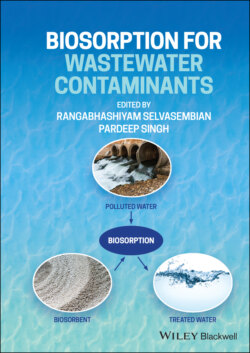Читать книгу Biosorption for Wastewater Contaminants - Группа авторов - Страница 30
Algae as Biosorbents
ОглавлениеAlgae are aquatic plants that have no real roots or stems and that range in size from microalgae to macroalgae. Algae are considered autotrophic, meaning they can produce enormous amounts of biomass even when little nutrition is available. They are regarded as good biosorbents because they have low nutrient requirements, are readily available, have significant sorption capacity, have a high surface‐to‐volume ratio, produce less sludge, do not produce harmful compounds, and have the potential for regeneration and recovery of metals (Trinelli et al., 2013). Microalgae (mostly green), macroalgae (brown algae), and red algae are the three types. Of the three varieties, brown algae have the greatest potential to absorb metals (Shamim, 2018). Biosorption of heavy metals by different algal species are summarized in Table 2.2.
Table 2.1 Biosorption of heavy metals by different bacteria.
| Bacterial biomass(biosorbent) | Metal ions(biosorbate) | Functional groups | Reference |
|---|---|---|---|
| B.subtilis | Chromium(III) | Carboxylic group | (Aravindhan et al., 2012) |
| E. coli | Chromium (VI) | Amine, phosphodiester groups | (Quiton et al., 2018) |
| B. thuringiensisOSM29 | Nickel | Amine, carbonyl, carboxylic, and hydroxylgroups | (Oves et al., 2013) |
| Arthrobacter sp. | Copper | Amine, carboxylic, and phosphate groups | (Aryal et al., 2012) |
| C. mutjisii | Zinc | Amine, hydroxyl, ketone, and phosphategroups | (Saranya et al., 2018) |
| Rhodococcus sp. | Arsenic | Amine, carboxylic, and hydroxyl groups | (Prasad et al., 2011) |
| Pseudomonas sp. | Cadmium | Amine, carboxylic, hydroxyl, and phosphategroups | (Huang and Liu, 2013) |
| B. pumilus sp. | Lead | Carboxylic and hydroxyl groups | (Sayyadi et al., 2017) |
| Cupriavidusmetallidurans | Silver | Amino, Carboxylic, and hydroxyl groups | (Shamim and Rehman, 2014) |
| Cupriavidusmetallidurans | Selenium | Amino, Carboxylic, and hydroxyl groups | (Shamim et al., 2014) |
| Enterobacter cloacae | Mercury | Amino, hydroxyl groups | (Rani et al., 2010) |
| Cupriavidusmetallidurans | Gold | Amino, Carboxylic, and hydroxyl groups | (Monsieurs et al., 2015) |
| Thiobacillusthiooxidans | Copper | Amine, hydroxyl, ketone, and phosphategroups | (Nagashetti et al., 2013) |
| Rhodopseudomonaspalustris | Cobalt | Amine, carboxylic, and phosphate groups | (Gao et al., 2017) |
| Bacillus safensis | Aluminum | Carboxylic and hydroxyl groups | (Dhanarani et al., 2016) |
Table 2.2 Biosorption of heavy metals by different algae.
| Algal biomass(biosorbent) | Metal ions(biosorbate) | Functional groups | Reference |
|---|---|---|---|
| Palmaria palmate | Chromium | Amino, carboxyl, sulfur groups | (Murphy et al., 2008) |
| Ulva lactuca | Cadmium | Amino, hydroxyl, carboxyl groups | (Lupea et al., 2012) |
| Spirulina platensis | Copper | Amino, carboxylic groups | (Çelekli et al., 2010) |
| Oedogonium hatei | Nickel | Amino, amide, hydroxyl and carboxyl groups | (Gupta et al., 2010) |
| Maugeotia genuflexa | Arsenic | Carboxyl, hydroxyl, amide groups | (Sarı et al., 2011) |
| Cladophorasp | Lead | Carboxyl, amino, amide, hydroxyl groups | (Lee and Chang, 2011) |
| Laminaria japonica | Zinc | Carboxyl, hydroxyl groups | (Davis et al., 2003) |
| Spirogyra hyalina | Cobalt | Amino, hydroxyl groups | (Viraraghavan and Srinivasan, 2011) |
| Sargassum sp. | Mercury | Amino, sulfur groups | (Subhashini et al., 2011) |
The cell wall components differ between algal species. Brown algae have three primary components in their cell walls: cellulose that provides structural support, alginic acid (mixture of polymers with their respective salts), and sulfated polysaccharide with large carboxylic groups implicated in metal biosorption. Red algae have garnered attention for biosorption due to the presence of sulfated polysaccharides formed from galactans (high concentrations of hydroxyl and carboxyl groups). Green algae have polysaccharide‐bound cellulose with a large amount of protein that includes amino, sulfate, hydroxyl, and carboxyl functional groups (Flouty and Estephane, 2012).
The algal cell wall consists of polysaccharides that include chemical groups (sulfate, amino, hydroxyl, phosphate, imidazole, mannan) known to function as binding sites for metal (Romera et al., 2007). Electrostatic interaction attracts cations due to the negative charge of the cell wall. In addition to the charge, which plays an essential role in biosorption, hydrophobicity, species and structure, ionic strength of the metal, and chemical makeup of the ionic solution of metals are also important factors to consider when choosing algae for biosorption. (Adewuyi, 2020).
The mechanism of metal absorption by algae is similar to bacteria: metal ions are bound to the outer membrane, followed by internalization. Algal biosorption involves one of two mechanisms:
Ion exchange process: ions such as calcium, magnesium, sodium, and potassium are replaced by metal ions on the algal surface.
Functional groups and metal ions combine to form complexes.
Ionic strength and covalent interactions are hypothesized in the case of the metal uptake process. Carboxyl and sulfate groups form ionic bonds, but amino and carboxyl groups require covalent interaction between the metallic ligand and the chemical group. Phytochelatins are formed within the algal body in response to metal ions (Abbas et al., 2014).
Multiple researchers worked on exploiting algal biomass to remove heavy metals from polluted water sources. Algal biosorption capacity is 15–84% more than other microorganisms, according to research (Mustapha and Halimoon, 2015). As a result, algal biomass is seen as a cost‐effective and ecologically beneficial wastewater treatment option.
